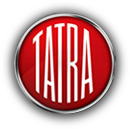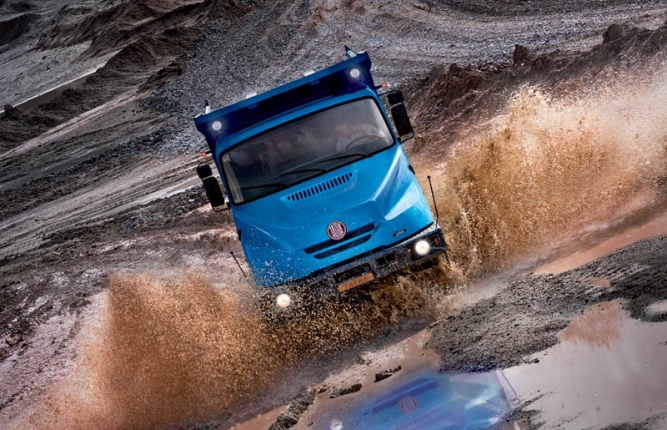- About the Company
TATRA today
- Company profile
- ET-link
- Company bodies and Organisation Chart
- Quality Management
- TATRA METALURGIE a.s.
- Sponsorship
History of TATRA
Tatra Trucks company won the prestigious Red Dot award for the design of the latest generation of Tatra Force model line
A few days ago, Tatra Trucks company achieved another great success. For the first time in its history, it won the Red Dot award in the Product Design category, even twice. Tatra Force vehicles of the latest third generation were decorated with this award, which is one of the most prestigious internationally in the field of design, while a version with a four-door cab was presented, as well as a version of the development line known as e-Drive with an electric traction motor and hydrogen fuel cells.
- Why TATRA
- Trucks
TRUCKS BY INDUSTRY SEGMENT
PRODUCT CATALOG
- Your TATRA partner
After-sales Services
Customer Centre
Original spare parts
Other
Dealer and Service Network
With the exception of Antarctica, you will find TATRA on every continent. We offer the largest network in Europe.
- Spare parts
- Contact
- Career
TATRA trucks going to quarries
20 September, 2011
The TATRA company begins to develop a new market segment in Russia. In the west, they use a succinct word "mining" for it (it is a segment of trucks designed to work in quarries).
We interviewed Sergey Galkin, Mining Marketing Manager of TATRA, a.s., about prospects opening up for the Czech company with such a move and about strengths of TATRA trucks.
How big is the Russian market segment of mining trucks at the moment, and what vehicles is the TATRA company going to launch there?
Our country is mining, so the mining equipment market is quite extensive. Currently, there are about five thousand mines in Russia. About 40% of them are relatively small, with annual production below 1.5 million tons. Here, we would like to offer three TATRA truck models, namely two three-axle ones with a payload of 20 and 25 tons and a four-axle truck with a carrying capacity of 30 tons; soon, we would offer the market a 35-ton truck. This is the segment of payloads we are going to compete in.
Who are you competing against?
Today, there are three types of mining trucks for work in quarries. The first of them is a mining truck equipped with a rigid axle such as BelAZ. Here, there are also both of the models with the giant capacity exceeding 100 tons, and then relatively small 30-ton models. The second type is represented by the domestic brands of standard heavy-duty road trucks, i.e. MAZ and KrAZ. However, these vehicles are slowly giving way to a third truck type – the articulated dump truck. Their sales have increased annually by 20-30% in Russia. We are looking at payload of 25-35 tons, so these are our main competitors.
You haven't mentioned Chinese trucks coming to the Russian market.
The trucks are used on internal roads in quarries before they need to be overhauled after reaching 15,000 working hours or, on average, 5,000 working hours per year. With the same intensity of work, Chinese trucks last for a year or two at most; then, you can write them off. The durability of Russian trucks is also comparable with Chinese trucks. However, getting spare parts for the Russian trucks is not much of a problem. On the other hand, Chinese manufacturers often change their component suppliers, so it often happens that after three or four years, customers just cannot get spare parts for the vehicles they purchased. That is why the Chinese products do not meet requirements of the mining industry customers.
Thus, in the mining market, the most successful manufacturers are those ones who are able to ensure reliability of trucks and guarantee spare parts availability for at least ten years by providing resources needed to overhaul them after at least 15,000 working hours. TATRA trucks fully meet these requirements.
Articulated dump trucks have truly phenomenal off-road capability. Will TATRA trucks, which are in principle remaining road trucks, be able to compete with them off roads?
In this market segment, off-road capability is the most important parameter! In springs and falls after the rains, quarries have a so-called "window" when mining trucks or heavy duty road trucks simply cannot be used. As a result, there is a gap in the operating cash flow of the company, and there are losses. However, articulated dump trucks can be used on any roads, which is why demand for them is growing. But TATRA trucks are also able to work year-round without compromising on their performance due to difficult road conditions.
How is it possible the articulated dump trucks achieve such a high off-road capability?
Firstly, it is the articulated mechanism which prevents the wheel to lose contact with any type of terrain, and secondly, the imposing diameter and width of the tires reducing rolling resistance and ground pressure. TATRA trucks cope with that thanks to their concept of independently suspended swinging half-axles ensuring the wheels never lose contact with the road. Moreover, 16R20 front tires and 24R21 rear tires help overcome even deep mud.
As regards the off-road capability of TATRA trucks – everything is clear. And what about TATRA trucks modified for work in quarries on the basis of other specifications?
As the truck is permanently operated on typical roads in quarries, the frame of the mining dump trucks has to withstand very big loads. Because of that, manufacturers make the frames very robust and therefore, the frames are very heavy. On the other hand, the TATRA truck has a central load carrying tube, which is basically a pipe that works much better for torsion forces. TATRA trucks weigh, therefore, much less. For example at a comparable load capacity of 30 tons, the BelAZ mining truck is a half times heavier than an articulated dump truck and two times heavier than a TATRA.
Due to the lower curb weight, our truck is more economical. This is the reason for lower operating costs compared with articulated dump trucks; even bigger savings are reached in comparison with mining trucks. And this is an important advantage today!
In addition, TATRA trucks are equipped with air-cooled diesel engines which require minimum consumption and are easy to maintain and repair. So, the trucks equipped with air-cooled engines are interesting to be operated in remote locations. For operation in quarries with high dust content, the TATRA company has just introduced a range of models equipped with water-cooled engines.
I must say that one of the coal mines in the Czech Republic operates about seventy 25-ton TATRA trucks and in comparison with VOLVO articulated dump trucks, they show very good results.
Entering the Russian mining truck market what position are you aiming to reach?
Naturally, TATRA trucks cannot replace all the technology with the payload of 20-40 tons which is used in quarries. For example, TATRA trucks cannot successfully compete with a half of them in the category of 40-ton payload, as our trucks are included in a transport restriction concerning axle loads due to their lower load capacity. However, having comparable off-road capability with articulated dump trucks and being 20-30% less expensive than articulated dump trucks in the range of 25-35-ton payload, TATRA trucks are fully capable of taking over 10-20% of the Russia's mining truck market.
Constantine Zakurdaev / Sergey Galkin







